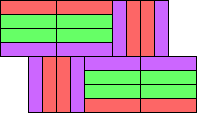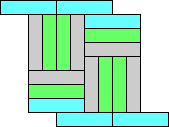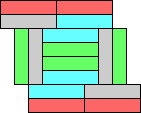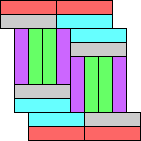




 | 1 | 2 |
|---|---|---|
| 1 | 
| |
| 2 | 
| 
|
| 3 | none | 
|
|
|
|
|
|
|
|
|
|
|
|
|
|
|
|
|
|
|
And then there's this one:

| {2} | {3} | {4} | {2,3} | {3,4} | {3,5} | {4,5} | {3,6} | {4,6} |
|---|---|---|---|---|---|---|---|---|

| 
| 
| ||||||

| 
| 
| 
| 
| 
| 
| 
| 
|

| 
| 
| 
| 
| 
| 
| ||

| 
| 
| 
| 
| 
| 
| ||
 (GS) |  (GS) |  (GS) |  (GS) |  (GS) |  (GS) |  (GS) | ||
 (GS) |  (GS) |  (GS) |  (GS) |  (GS) |  (GS) |  (GS) | ||
 (GS) |  (GS) |  (GS) |  (GS) |  (GS) |  (GS) |  (GS) | ||
 (GS) |  (GS) |  (GS) |  (GS) |  (GS) |  (GS) |  (GS) | ||
| {2} | {3} | {4} | {2,3} | {3,4} | {3,5} | {4,5} | {3,6} | {4,6} |
| {2,3,4} | {3,4,5} | {3,4,6} | {3,5,6} | {4,5,6} | {3,4,7} | {4,5,7} | {2,3,4,5} | {3,4,5,6} | {3,4,5,7} | {3,4,6,7} | {3,4,5,6,7} |
|---|---|---|---|---|---|---|---|---|---|---|---|

| 
| 
| 
| 
| |||||||
 (GS) |  (GS) | ||||||||||
 (GS) | 
| 
| 
| 
| 
| 
|  (GS) |  (GS) | 
| ||
 (GS) |  (GS) |  (GS) |  (GS) | ||||||||
 (GS) |  (GS) |  (GS) |  (GS) |  (GS) | |||||||
 (GS) |  (GS) |  (GS) |  (GS) | ||||||||
 (GS) |  (GS) |  (GS) |  (GS) |  (GS) |  (GS) |  (GS) |  (GS) |  (GS) | |||
| {2,3,4} | {3,4,5} | {3,4,6} | {3,5,6} | {4,5,6} | {3,4,7} | {4,5,7} | {2,3,4,5} | {3,4,5,6} | {3,4,5,7} | {3,4,6,7} | {3,4,5,6,7} |
If you can extend any of these results, please e-mail me. Click here to go back to Math Magic. Last updated 11/1/19.